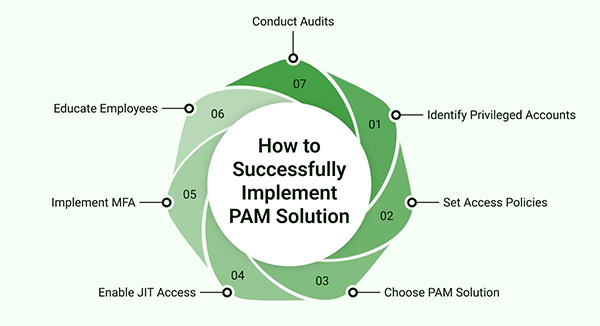
Did you knowF that most data breaches involve an abuse of privileged access? A single stolen password or vulnerability in your system allows cybercriminals to move around undetected, causing data breaches and reputation damage.
It simply means a single unchecked admin account can bring your entire organization to its knees. Yes, it sounds scary! You can avoid this damage by implementing privileged access management software. It will ensure that the right people in your organization have access to the critical systems.
As it is the gatekeeper of your organization’s sensitive accounts, you need to take a strategic approach to implement it. This article will take you through the step-by-step process of implementing PAM software to improve effectiveness while reducing the risks.
A Step-by-Step Process to Successfully Implement PAM
This section outlines the key steps for implementing PAM effectively, covering account discovery, policy enforcement, tool selection, access controls, monitoring, training, and continuous improvement.
Step 1. Assess and Identify Privileged Accounts and Security Gaps
Do you know who can access the most sensitive systems and information in your organization? No! You may be posing a major risk to your organization if everyone has access to all the information.
Your first step to implementing the PAM software involves assessing and identifying the privileged accounts in the company. You should follow it by determining the security gaps that exist in the ideal security system.
Begin the entire process by conducting a detailed audit of all the accounts that possess elevated access. These include database managers, third-party vendors, and system administrators. Check the privileges they possess and how often they are used. You might notice some accounts are overused or possess extra privileges, which attracts security risks.
Identify the people who can access accounts, what they can do, and if the privileges are in sync with their designations. You should watch out for excessive permissions and vulnerabilities that can be attacked. With this detailed understanding of the system, you can identify and eliminate the vulnerabilities in the system.
Step 2. Set Strong Access Policies and Least Privilege Controls
Does it sound sensible to hand over the master key to all employees in your organization? No, right? So, why would you do it with privileged access? There are very few people in the organization who may need all privileges.
To ensure proper security and minimum vulnerabilities, you must implement strong access policies and minimize the privilege controls. You should limit the access, providing what’s necessary for the particular department or access need.
In some cases, you might need to grant privileges to the employee. You can use temporary or time-bound access instead of standing privilege to eliminate the risks. Using the principle of least privilege, you can mitigate risks, avoid giving unnecessary permissions, and improve overall security.
Step 3. Pick the Right PAM Solution for Your Security Needs
Not all Privileged Access Management software solutions are the same. By choosing the wrong software, you are paving the way for security gaps. It is crucial to select the right PAM solution for effective privilege management and seamless integration with your IT infrastructure.
Evaluate your organization’s security requirements to understand if you need a cloud-based PAM or on-premise solution. Look for features like session monitoring, automated credential rotation, or audit trails for the perfect solution.
Make sure the software solution is scalable and easy to integrate so that it can adapt to newer needs and elevate the functionality. You must invest in proper assessments and selection to get PAM software that enhances compliance and improves security.
Step 4. Enable Just-in-Time Access and Real-Time Monitoring
Imagine walking into the bank and seeing the vault door open so that people can grab what they want from it. Doesn’t feel right, does it? Leaving your privileged accounts exposed is akin to keeping the vault door open.
You can change this by using just-in-time access with real-time monitoring to improve operational efficiency. You can grant time-bound access to the privileged accounts to the users, reducing the need for permanent access or credentials.
With an excellent combination of JIT access and continuous monitoring, you can eliminate credential-driven attacks and improve accountability. It can strengthen the security of your organization.
Step 5. Lock Down Privileged Accounts with Multi-Factor Authentication
Changing the password alone may not stop the cyber attacks. However, with layered security, you can eliminate the risks. You must implement multi-factor authentication to prevent unauthorized access to these accounts.
What happens with this layered authentication to locked-down accounts? Even if your hacker gets hold of the password, they cannot access it owing to the extra layer. They would need a one-time password or biometrics to access the account.
You must enforce MFA at every access point to secure the PAM software. Consider implementing adaptive authentication for admin accounts and sensitive systems. It can reduce phishing and brute force attacks. Moreover, it can improve access to critical resources, ensuring only authorized users access it.
Step 6. Educate Your Team to Prevent Insider Threats
If your employees are not trained to use the systems, your security is as good as vulnerable. While technology can secure the gates to your organization, a single human error can bring down the organization with cyberattacks.
You must have a well-informed and trained team as your first line of defense against insider threats. This way, you can prevent accidents and malicious attacks.
You can begin by conducting security awareness training in your organization. This training should cover password hygiene, privileged access best practices, and phishing detection. Train your employees on privilege misuse and the importance of adopting PAM policies.
You can foster a security culture in the organization by getting people to report suspicious activities and implementing PoLP (principle of least privilege).
Step 7. Keep PAM Strong with Continuous Audits and Improvements
Implementing the PAM software is the first step towards a strong and secure culture. Security threats evolve with time, and so should your defense mechanism.
You can ensure the PAM software is effective by conducting regular audits in the organization. Continuous monitoring and improvements can help your system adapt to the newer risks.
You should schedule the reviews and ensure the access is aligned with PoLP policies. Lastly, you should remove the orphaned accounts or outdated permissions to minimize the attacks. Flag anomalies and provide detailed compliance reports with auditing tools for better security policies.
Tip: You should also conduct fresh training and assess the need for new features to ensure the system remains effective.
Improve Security Through a Well-Planned PAM Implementation
Securing privileged accounts is no longer a luxury, but a necessity. As it is a high-value target, you need to ensure it is safe from attacks and unauthorized access. You cannot let people get information from your business and threaten to expose you later.
You must implement the privilege access management software to ensure you follow the least privilege policy and implement the MFA for better security. Start your implementation by assessing the needs, enabling just-in-time access, and offering continuous audits to improve defense.
PAM software isn’t a one-time fix for your organization. If you want to stay ahead of vulnerabilities, you must monitor and improve them continuously to ensure regulatory compliance and best practices. Prioritize PAM today for your organization to protect your data assets and reputation.







